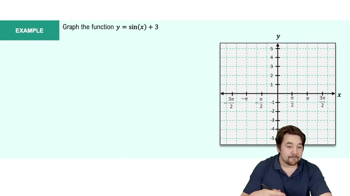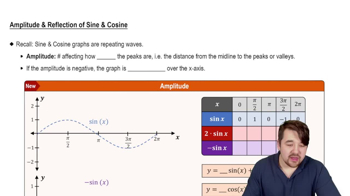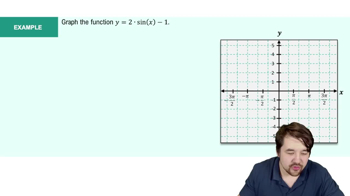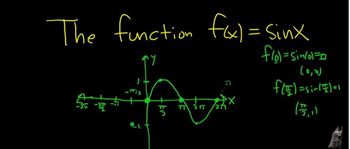Table of contents
- 0. Review of College Algebra4h 43m
- 1. Measuring Angles39m
- 2. Trigonometric Functions on Right Triangles2h 5m
- 3. Unit Circle1h 19m
- 4. Graphing Trigonometric Functions1h 19m
- 5. Inverse Trigonometric Functions and Basic Trigonometric Equations1h 41m
- 6. Trigonometric Identities and More Equations2h 34m
- 7. Non-Right Triangles1h 38m
- 8. Vectors2h 25m
- 9. Polar Equations2h 5m
- 10. Parametric Equations1h 6m
- 11. Graphing Complex Numbers1h 7m
4. Graphing Trigonometric Functions
Graphs of the Sine and Cosine Functions
Problem 4.45b
Textbook Question
Graph each function over a one-period interval. See Example 3.
y = (3/2) sin [2(x + π/4)]
 Verified step by step guidance
Verified step by step guidance1
Identify the standard form of the sine function: \( y = a \sin(b(x - c)) + d \).
Determine the amplitude \( a \) from the equation \( y = \frac{3}{2} \sin(2(x + \frac{\pi}{4})) \), which is \( \frac{3}{2} \).
Find the period of the function using the formula \( \text{Period} = \frac{2\pi}{b} \), where \( b = 2 \).
Calculate the phase shift \( c \) by solving \( x + \frac{\pi}{4} = 0 \), which gives the shift to the left by \( \frac{\pi}{4} \).
Graph the function over one period, starting from the phase shift and using the calculated amplitude and period.
 Verified video answer for a similar problem:
Verified video answer for a similar problem:This video solution was recommended by our tutors as helpful for the problem above
Video duration:
0m:0sPlay a video:
Was this helpful?
Key Concepts
Here are the essential concepts you must grasp in order to answer the question correctly.
Sine Function
The sine function is a fundamental trigonometric function that relates the angle of a right triangle to the ratio of the length of the opposite side to the hypotenuse. It is periodic with a period of 2π, meaning it repeats its values every 2π radians. Understanding the sine function is crucial for graphing and analyzing its transformations.
Recommended video:

Graph of Sine and Cosine Function
Transformations of Functions
Transformations of functions involve shifting, stretching, or compressing the graph of a function. In the given function, the term (x + π/4) indicates a horizontal shift to the left by π/4, while the coefficient (3/2) affects the vertical stretch of the sine wave. Recognizing these transformations is essential for accurately graphing the function.
Recommended video:

Domain and Range of Function Transformations
Period of a Function
The period of a function is the length of one complete cycle of the function's graph. For the sine function, the standard period is 2π, but it can be altered by a coefficient in front of the variable, as seen in the function y = (3/2) sin [2(x + π/4)]. Here, the coefficient 2 compresses the period to π, which is vital for determining the interval over which to graph the function.
Recommended video:

Period of Sine and Cosine Functions

 5:53m
5:53mWatch next
Master Graph of Sine and Cosine Function with a bite sized video explanation from Nick Kaneko
Start learningRelated Videos
Related Practice
















